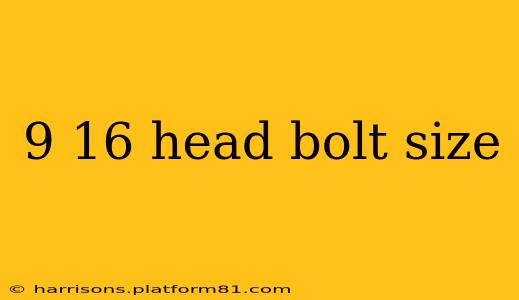The 9/16" head bolt size is a common fastener used in various applications, from automotive repairs to industrial machinery. Understanding its specifications and applications is crucial for anyone working with nuts and bolts. This guide provides comprehensive information on the 9/16" head bolt, addressing common questions and offering valuable insights.
What is a 9/16" Head Bolt?
A 9/16" head bolt refers to a bolt with a head diameter of 9/16 of an inch (approximately 14.29 millimeters). The head size is a key identifier, impacting the wrench size needed for tightening and the overall strength of the connection. However, the head size alone doesn't fully define the bolt. Other crucial specifications include:
- Thread Size: This specifies the diameter and pitch (distance between threads) of the bolt's threads. A 9/16" head bolt could have various thread sizes, such as 1/2"-13 UNC (Unified National Coarse), 5/8"-11 UNC, or others. The thread size dictates the nut required and the load-bearing capacity.
- Bolt Length: This determines the overall length of the bolt, including the head and threaded portion. The length is chosen based on the thickness of the materials being joined and the desired clamping force.
- Bolt Material: The material significantly influences the bolt's strength, corrosion resistance, and temperature tolerance. Common materials include steel (various grades), stainless steel, and alloys like brass or aluminum.
- Head Style: While the diameter is 9/16", the head style can vary. Common head styles include hex (six-sided), square, and button heads. The head style impacts the wrench type required and the aesthetic appearance.
What are the Applications of a 9/16" Head Bolt?
Due to its relatively robust size, a 9/16" head bolt finds applications in numerous sectors:
- Automotive: Used in various engine components, suspension systems, and chassis parts.
- Industrial Machinery: Frequently employed in heavy-duty equipment, securing components under significant stress.
- Construction: Used in structural applications where high tensile strength is required.
- General Fabrication: A versatile fastener for many projects involving metal joining.
Choosing the right 9/16" head bolt requires careful consideration of all these factors – not just the head size.
What is the Torque Specification for a 9/16" Head Bolt?
There's no single torque specification for a 9/16" head bolt. The required torque depends heavily on the bolt material, thread size, and the application. Always consult the manufacturer's specifications or a reputable torque chart for the specific bolt and application. Over-tightening can damage the bolt or the connected components, while under-tightening can lead to loosening and failure.
How Do I Identify a 9/16" Head Bolt?
Visually inspecting the head diameter is a starting point. Using a caliper or a wrench that fits snugly will confirm the head size. However, determining the complete specification (thread size, length, material) often requires closer examination or consulting markings on the bolt itself (if present).
What Size Wrench Do I Need for a 9/16" Head Bolt?
While a 9/16" wrench should fit, this is not guaranteed. The actual wrench size depends on the head style. A 9/16" wrench will likely fit a hex head, but other head types might require different wrenches. Therefore, always measure or check the bolt head carefully before choosing a wrench.
What is the Difference Between a 9/16" Bolt and a 9/16" Nut?
A 9/16" bolt refers to the head diameter of the bolt, while a 9/16" nut refers to the inside diameter where the bolt threads engage. They are related but distinct measurements, ensuring that a bolt of a specific size matches the corresponding nut. Confusing these measurements could result in improper fastening.
This comprehensive guide offers a deeper understanding of the 9/16" head bolt, highlighting its applications and the importance of considering all its specifications. Always prioritize safety and consult relevant resources when working with fasteners. Remember to always refer to manufacturer's specifications for correct torque values and proper installation procedures to ensure the safety and integrity of your project.
